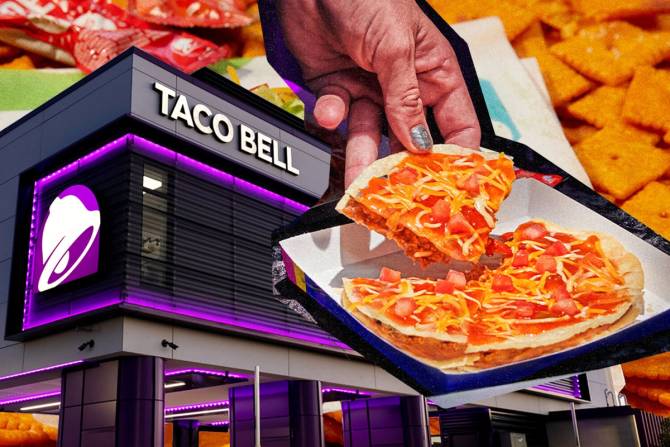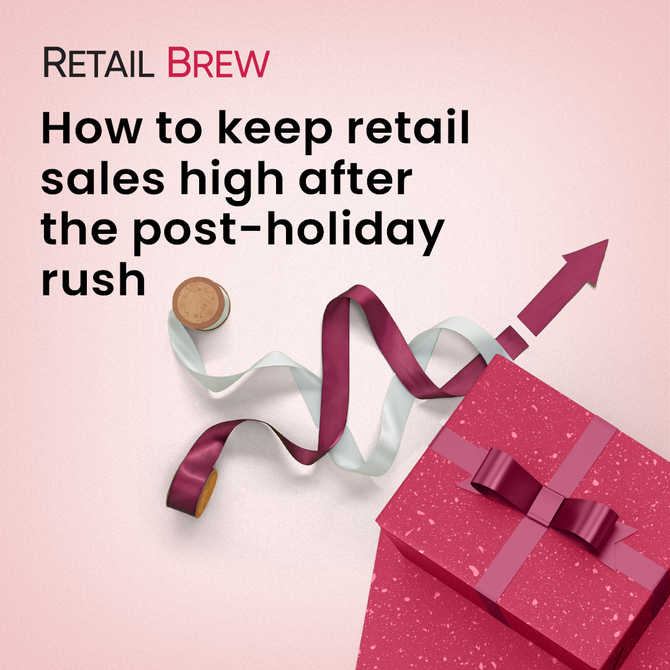Happy Monday! We’re rounding up the biggest happenings in fashion from 2022, but after what soccer fans are calling the best World Cup final ever, we’re assuming everyone is sporting the blue and white stripes of Team Lionel Messi…I mean, Argentina.
In today’s edition:
—Jeena Sharma, Erin Cabrey, Andrew Adam Newman
|
|
Giphy
A lot happened in fashion this year. Creative directors from brands like Gucci left their companies and others like Prada tapped new executives, while Raf Simons shut down his namesake brand. Meanwhile, the fashion world also bid adieu to some iconic names, such as Issey Miyake who passed away in August.
While it’s impossible to highlight literally everything that happened in the industry, we’ve compiled a comprehensive recap of the biggest trends that dominated fashion in 2022.
The rise of resale: Shopping brand new is out; shopping secondhand is in. This was a big year for resale, and practically every brand, from luxury to fast fashion, wanted a piece of it.
In a previous conversation, Sarah Davis, founder, president, and CCO of Fashionphile, told us that both men and women were investing in secondhand items, a trend that is only going to continue.
“I feel like one of the things that’s really nice in luxury: There’s not a trend that’s…not going to sit around for two months,” she said. “If you want to get in on the trend in our category, where it’s more expensive, it’s just nice that it’s got staying power.”
The year of NFTs: If it seemed like all fashion brands wanted to talk about this year was the metaverse and NFTs, that’s because it’s arguably true. Across the globe, brands intensified their investment in the market by debuting digital avatars of their products and even doing their shows in the metaverse.
Inventory, inflation, and more troubles: Retailers were up against quite a bit in 2022, and fashion brands were no exception. Inflation, lockdowns in China, the strengthening dollar, and the looming recession were only the tip of the iceberg that, in turn, created other issues such as excess inventory and a prolonged supply-chain crisis.
Keep reading here.—JS
|
|
TOGETHER WITH TWILIO SEGMENT
|
|
New customers are costly. Companies usually have to spend a lot more $$$ to find new customers than to retain existing ones—up to 25 times more. That shocking stat means every brand should have a customer retention strategy in place. What’s yours?
Twilio Segment’s Ultimate Guide to Customer Retention takes a deep dive into how you can keep your customers and avoid the rising costs of customer acquisition. Peep the guide to find out:
- the 5 metrics to measure customer retention and identify churn risk
- proven strategies that drive engagement and increase customer lifetime value
- how a customer data platform (CDP) leads to increased customer engagement
Ready to retain? To learn more about the key trends that impact customer retention, download the full guide here.
|
|
Photo Illustration: Dianna “Mick” McDougall, Source: Taco Bell
Taco Bell’s 60th anniversary year was sufficiently stuffed, from Mexican Pizza’s comeback to the opening of its biz school, but there’s a lot to come in the new year as well. Taco Bell CEO Mark King looked into his crystal bell ball to share what’s in the works for the chain in 2023, especially as it expands its efforts in sustainability and establishing a diverse workforce.
This is the conclusion of a two-part interview. Part 1 reflected on the major moves for Taco Bell in 2022. This interview has been edited and condensed for clarity.
Can you share some of the main goals, sustainability-wise, for Taco Bell next year?
There’s three. Specifically, one is we want to make the headquarters more sustainable. And to me, that means maybe 100% sustainable. Now, that’s an ambition; I don’t think we’ll get there in 2023. But that’s on everything that we do—on energy, on waste reduction, on silverware, cups—just everything, because I think if we can’t walk the walk at our own headquarters, then I think our voice doesn’t ring very true…Second is to continue our program with TerraCycle. I think we’ve recycled more than 135,000 packets since we launched that program, so that’s definitely something we want to continue. And then we’re looking at building restaurants that are more recycle-friendly. And it just starts with where do you throw your food out into rather than one big waste bin, but to divide that into recycle and compost and waste.
Keep reading here.—EC
|
|
|
It’s time to start manifesting your financial freedom, and Money with Katie is here to help. Her weekly newsletter takes a spicy approach to spending habits, investing best practices, credit card hacks, and more. Get simple, practical ways to live a rich life delivered straight to your inbox for free.
|
|
Today’s top retail reads.
Who runs the (virtual) world?: Women have notoriously been excluded from the c-suites of tech companies, and the field of virtual reality is proving no different. But in the gaming world Roblox, a popular platform among brands looking to experiment in the metaverse, women designers are carving out their own space. (Elle)
Dog days of shopping: In an attempt to bring back pre-pandemic foot traffic, some malls have decided to allow shoppers to bring their four-legged friends with them. From allergies to pup cups, the results have been mixed. (the Wall Street Journal)
Hitting the right note: From “Jingle Jamz” to “Country Christmas,” SiriusXM works with business experts and musicologists to create playlists that set the right mood for retail stores. And they say retailers are streaming those playlists earlier and earlier, with Gap and Old Navy leaning into their holiday soundtracks at the end of October. (Bloomberg)
|
|
The holiday season is one of the most significant moments for retailers, bringing in nearly $800 billion annually.
But what happens after the holiday rush? Many businesses enter a so-called “post-holiday slump,” which can pose a serious financial challenge if they’re not prepared to combat it.
Don’t let that happen to you. Download Retail Brew’s guide for quick tips on finding sales success in the new year.
Read it here.
|
|
-
LVMH is planning a new factory dedicated to creating Louis Vuitton bags in Tuscany, the luxury conglomerate’s third factory making the brand’s products in the region.
-
Amazon workers at one of its warehouses in the UK voted to go on strike, with a walkout likely in January. Meanwhile, in the US, the company allegedly “failed to properly record work-related injuries and illnesses at six warehouses in five states,” according to the Department of Labor.
-
JD Sports, which owns Finish Line, sold 15 “non-core” brands to British company Frasers Group for ~$58 million.
-
DressX, a digital fashion platform, is teaming up with Warner Music Group to create virtual merchandise for fans.
-
Build-A-Bear Workshop is bringing teddy customization to the metaverse with a new experience on Roblox.
-
Saks OFF 5th, Saks Fifth Avenue’s discount outlet, said it will reopen two locations in Chicago.
-
Taco Bell is testing out two new types of fan-favorite menu item Mexican Pizza.
|
|
At the mall, it’s where band tees are the only tees. In Retail Brew, it’s where we invite readers to weigh in on a trending retail topic.
As e-commerce has grown, so have reports of stolen packages.
-
Nearly one in four (23%) of Americans had at least one package stolen in the three months leading up to March 2022, according to an annual national package-theft report from Security.org.
- The majority of Americans (54%) have had at least one package stolen at some point, the report found.
Now, a startup backed by New York Giants cornerback Adoree’ Jackson called PorchPals is pitching a solution for the problem with a novel approach to package insurance. While per-package insurance is common from USPS and other carriers, and paid for either automatically by retailers or electively by shoppers at checkout, PorchPals is different.
- Consumers pay $15 monthly (or $120 annually) to cover packages shipped by any retailer using any major shipper. PorchPals covers up to three claims annually and/or a collective value of up to $2,000 annually.
The policies became available in California on November 28, with plans to expand nationally in early 2023.
You tell us: Would it be worth it to you to pay $120 annually for package insurance that could cover up to $2,000 worth of stolen packages? Cast your vote here.
Circling back: Last week, we asked you about Tablz, a booking app that gives restaurants the option of charging more for better tables, with prices for upgrades ranging from $5 to $100, depending on the day and hour.
We asked if you thought restaurants charging more for better tables was a good strategy…and you pretty much started throwing plates at the wall, with 84.5% of you saying no, restaurants shouldn’t charge more for better tables. Another 12.9% of you approved of the practice, while 2.7% didn’t know or didn’t have an opinion.—AAN
|
|
Catch up on the Retail Brew stories you may have missed.
|
|
|
Written by
Jeena Sharma, Erin Cabrey, and Andrew Adam Newman
Was this email forwarded to you? Sign up
here.
|
ADVERTISE
//
CAREERS
//
SHOP 10% OFF
//
FAQ
Update your email preferences or unsubscribe
here.
View our privacy policy
here.
Copyright ©
2022
Morning Brew. All rights reserved.
22 W 19th St, 4th Floor, New York, NY 10011
|
|







